STAKHANOVISTS OF ALL COUNTRIES,
![]()
Words are, of course, the most powerful
drug used by mankind. Rudyard Kipling.
On September 1, 1935, the newspaper Pravda, organ of the communist party, reported that a Donbas miner named Stakhanov had extracted 102 tons of coal in a six-hour shift, exceeding the norm more than fivefold. Thus began the Stakhanovite "movement" -- a campaign urging workers to emulate this and other alleged feats of super-productivity.
Professor Bob Davies (Centre for Russian and East European Studies, University of Birmingham, UK) and Oleg Khlevnyuk (State Archive of the Russian Federation) have mined newly accessible archives to uncover the political and economic background to this campaign and assess its impact.
Following the upheaval of forced-pace industrialization associated with the first Five Year Plan (1928-33), the Soviet leadership shifted in 1934 and early 1935 to a policy of consolidation, with a more modest level of capital investment and a stress on financial stabilization. ...
Thus there took shape the strategy of "substituting intensification for investment" -- that is, squeezing more out of less -- even if that meant pushing the capacity of both machines and workers up to and beyond their limits. When Soviet workers master the new technology, Stalin declared on May 4, 1935, they can and must "bring about miracles." The Stakhanovite movement gave the leadership a justification to revise workers' output norms upward at the beginning of 1936. Those who warned of the dangers of ignoring objective limits were prosecuted (read sent to Gulag) for sabotage.The stamp shown below, issued by USSR in 1985, commemorates 50 years of the Stakhanovist movement. It reads: "Yesterday a limit for an innovator, today a working norm."
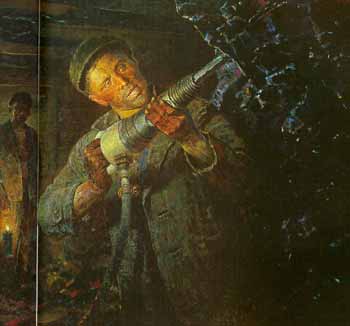 |
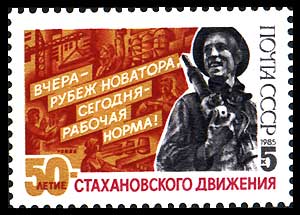 |
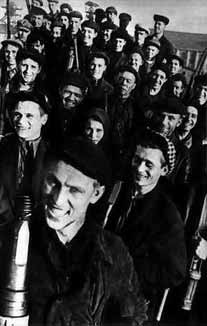 |
The movement did not last very long. "Only 1936 can properly be described as a 'Stakhanovite year'" -- and from July 1936 there was a shift back to more balanced growth. In 1937 Stakhanovism (like much else) was overwhelmed by the purges; in 1938 it was revived but on a low key. It appears that Stalin came to the realization that Stakhanovism was not yielding the hoped-for results and decided quietly to abandon it. We know today that there was a full team who worked during the night for Stakhanov (revealed, for example, in Solzhenitsyn's "Gulag Archipelago").
We illustrate the "movement" by a "work of art" and a propaganda photography. The first in the row is, of course, the Hero of the Socialist Work, the unforgettable Stakhanov. Fifty years later the USSR post issued a stamp that commemorates 50 years of the "Stakhanovist movement". The slogan written on it "Yesterday a frontier of an innovator, today a working norm" shows that as well the problems as the solutions didn't change much after a half of a century.
The parallel to the "Great Leap Forward" of 1958-61 and to Dazhai experiment in China are quite obvious. Like Stalin, Mao Zedong sought a short cut to industrial development by driving people to "miraculous" feats. Just that Mao's insanity lasted longer and did incomparably more harm. Millions of peasants, forced to neglect their crops and build useless backyard steel furnaces or to use only manpower in agriculture, were starved to death.
The Dazhai (written also as Tachai) production team in a Chinese province became in 1964 a model for the entire China, as result of Mao Zedong call "In agriculture, learn from Dazhai". Dazhai's farmers have turned their infertile soil into a productive one by using just manpower and hard work.
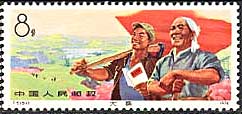 |
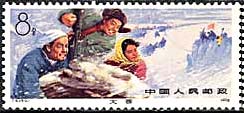 |
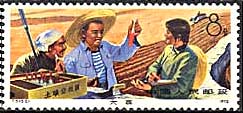 |
The main "hero" of the moment was a certain Chen Yonggui, a China Communist Party (CCP) member who was designed for this job by the upper Nomenclature. Chen was usually shown with a towel around his head. His basic activity was creating working teams named "Oldsters and Youngsters" or "Iron Girls", who did the hard work that was needed to convert barren Dazhai into a "Pacesetter in China's Agriculture". As a reward for his achievements, between 1973 until 1980 Chen Yonggui became a member of the Politburo, and from 1975 until 1980, he even served as one of China's Vice-Premiers.
Dazhai had become the main example to follow for all agricultural production. Its example became mandatory everywhere, regardless of what the local conditions might be. Because daily some 20,000 persons visited Dazhai and studied this model of autonomy and initiative, large facilities were foreseen for those important visitors, sent by the party from the whole China.
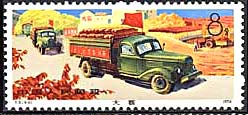 |
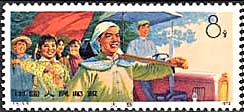 |
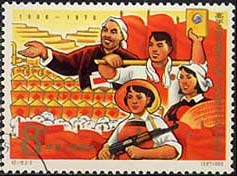 |
Those who followed Dazhai's experiment had often experienced unexpected, even disastrous consequences, particularly in areas with abundant water resources. The Dazhai model was officially abandoned in the 1980s. It transpired then that Dazhai's wonders were the result of the extensive commitment of the People's Liberation Army. Heavy agricultural tools had been used by the army, even if Dazhai had been propagated as a model that relied on pure manpower and on advances of proletarian thought.
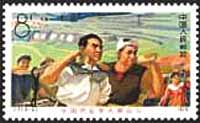 |
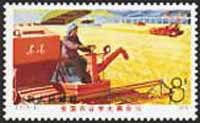 |
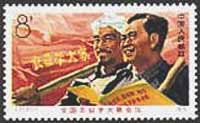 |
By the late 1990s, Dazhai's inhabitants turned their backs to this shameful past. Only about 20% of villagers still work in agriculture today. Even more, most of the arable land has been turned into orchards and dense woods.
The set of five stamps, shown above, on the first and on the second row, was issued on Sept. 30, 1974, Sc. 1119-1203. It is called: Farmers of Tachai as Examples of Achievement. The last stamp of the second row is from a set of two, Sc. 936-937, Third Five-Year Plan. Dedicated to the agricultural grows, one can recognize on him Chen Yonggui, who appears also on the first row, on the left stamp, on the second row on the right, and on the second poster (with Mao's red book in his hand).
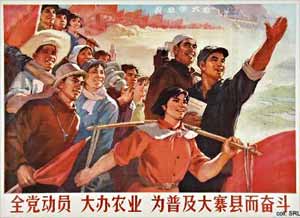 |
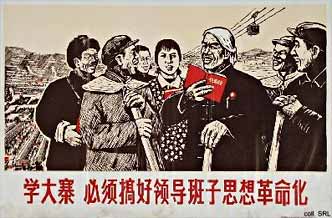 |
The set of three stamps shown on the third row, was issued on Oct. 1, 1975. It commemorates the National Conference to promote learning from Dazhai's achievements in agriculture. Please note that, contrary to the CCP's propaganda song, and in order to give a nicer image of the usually backbreaking work, the woman on the central stamp is driving a harvester combine.
Point on the stamps with the mouse for more information. Text and both posters (reduced) courtesy of Stefan Landsberger's "Chinese Propaganda Posters" site .
Concluding, we can recognize the same methods, used as well in the 30's in USSR as in China of the 1960s and 1970s. Because the communist party couldn't convince the population to work for the future generations (and not for itself), it has appealed to an extensive propaganda, based on obvious lies. For this purpose both communists parties used an emblematic figure, like Stakhanov, who was a miner or Chen Yonggui, who represented the poor and lower-middle peasants. The alternative, but not very efficient method either was the use of force and repression, a subject that we'll treat on the pages dedicated to the Mao's 7th of May Directive and on others to follow.
Links:
Created: 07/26/03. Revised: 9/1/2024. |
